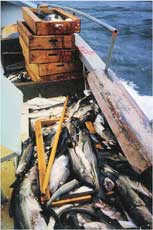Aug 27 2008
A study of Stone Age fish unearthed on an island in the Baltic Sea suggests overfishing by humans is causing fish populations to evolve and driving commercially valuable species like cod to the brink of economic extinction.
 Cod aboard a vessel in the Baltic Sea. SUNY College of Environmental Science and Forestry
Cod aboard a vessel in the Baltic Sea. SUNY College of Environmental Science and Forestry
In a report published today in the British scientific journal, Proceedings of the Royal Society B, an international team of scientists reports that 4,500-year-old earstones, known scientifically as otoliths, and vertebrae from Baltic cod found in a pre-Viking settlement on the Swedish island of Gotland indicate the fish harvested by Neolithic fishers were older and larger than those hauled in by 21st century trawlers.
Dr. Karin Limburg, a fisheries ecologist at the SUNY College of Environmental Science and Forestry (ESF) in Syracuse, N.Y., who is the paper’s lead author, described the status of the cod fishery in the Baltic as “dire.”
“It’s such an overfished system,” Limburg said. “The big concern is that overexploitation is causing the fish to evolve. The finding that humans can actually cause evolution of fish populations, which in turn can drive their degradation, is relatively new and is drawing a lot of attention.
“Some fisheries, including that for cod, are now known to cause ‘juvenescence,’ or the evolution of younger, smaller adult fish. The ecological and economic consequences both appear to be negative,” she said.
The findings were reported in one of two scientific journals published by the Royal Society, the United Kingdom’s national academy of science. Proceedings B publishes articles about the biological sciences.
Limburg collaborated on the study with Yvonne Walther of Sweden’s National Board of Fisheries; Bongghi Hong, an ESF research associate; Carina Olson, a doctoral student at the University of Stockholm; and Jan Storå, an archaeologist at the University of Stockholm.
“With cod populations at historic lows and challenges to rebuild them mounting, it is important to explore the past for clues about characteristics such as stock sizes, exploitation rates, age and size structure, etc. and what ecological roles cod would have played when their populations were larger,” the paper states.
Limburg said the research will provide baseline information so modern managers can better assess the fishery and plan for its future.
Extrapolating size, age, growth and mortality rates based on examination of the fish remains, the researchers concluded that Stone Age fisheries produced cod that were harvested at an average length of 56 centimeters, or a little more than 22 inches. By contrast, today’s catch averages 49 centimeters, a difference of about three-and-a-half inches.
The difference becomes more significant, Limburg said, when comparing the difference in fishing practices between Neolithic times and the modern era. Neolithic fishers worked from the shore and in simple boats that did not stray far out to sea. Today’s trawlers, by contrast, operate in the deepest waters, where the largest and oldest cod would typically live. Even so, the Stone Age fishers gathered bigger fish in the near-shore waters than today’s commercial ships collect much farther off shore, she said.
Modern fishing techniques, which target the largest fish, remove the older females from the seas. Older females produce the greatest number of viable eggs, Limburg said, and they likely have the most knowledge about how to find productive spawning grounds. In their absence, the fish left in the ecosystem are less likely to spawn productively.
In addition to the physical remains of the fish, the scientists used information gleaned from a collection of fish hooks found on Gotland. They replicated the bone hooks, measured their strength, and drew conclusions about the size of the fish they were designed to catch.
Vertebrae make up the spinal column of a fish. Earstones, known to scientists as otoliths, are made of calcium carbonate and are found in the heads of fishes. They play a role in the hearing and balance system of the fish. Earstones grow with the fish, developing rings much as a tree does. They provide a wealth of information about the age and growth of a fish community.